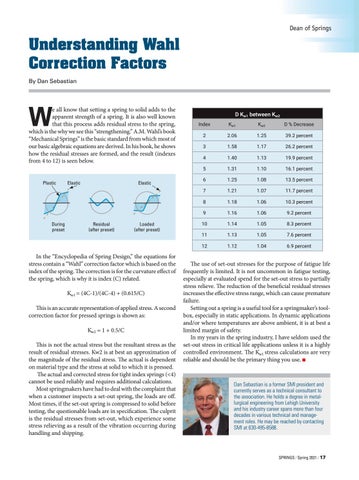Dean of Springs
Understanding Wahl Correction Factors By Dan Sebastian
W
e all know that setting a spring to solid adds to the apparent strength of a spring. It is also well known that this process adds residual stress to the spring, which is the why we see this “strengthening.” A.M. Wahl’s book “Mechanical Springs” is the basic standard from which most of our basic algebraic equations are derived. In his book, he shows how the residual stresses are formed, and the result (indexes from 4 to 12) is seen below. Plastic
During preset
Elastic
Elastic
Residual (after preset)
Loaded (after preset)
In the “Encyclopedia of Spring Design,” the equations for stress contain a “Wahl” correction factor which is based on the index of the spring. The correction is for the curvature effect of the spring, which is why it is index (C) related. Kw1 = (4C-1)/(4C-4) + (0.615/C) This is an accurate representation of applied stress. A second correction factor for pressed springs is shown as: Kw2 = 1 + 0.5/C This is not the actual stress but the resultant stress as the result of residual stresses. Kw2 is at best an approximation of the magnitude of the residual stress. The actual is dependent on material type and the stress at solid to which it is pressed. The actual and corrected stress for tight index springs (<4) cannot be used reliably and requires additional calculations. Most springmakers have had to deal with the complaint that when a customer inspects a set-out spring, the loads are off. Most times, if the set-out spring is compressed to solid before testing, the questionable loads are in specification. The culprit is the residual stresses from set-out, which experience some stress relieving as a result of the vibration occurring during handling and shipping.
D Kw1 between Kw2 Index
Kw1
Kw2
D % Decrease
2
2.06
1.25
39.2 percent
3
1.58
1.17
26.2 percent
4
1.40
1.13
19.9 percent
5
1.31
1.10
16.1 percent
6
1.25
1.08
13.5 percent
7
1.21
1.07
11.7 percent
8
1.18
1.06
10.3 percent
9
1.16
1.06
9.2 percent
10
1.14
1.05
8.3 percent
11
1.13
1.05
7.6 percent
12
1.12
1.04
6.9 percent
The use of set-out stresses for the purpose of fatigue life frequently is limited. It is not uncommon in fatigue testing, especially at evaluated spend for the set-out stress to partially stress relieve. The reduction of the beneficial residual stresses increases the effective stress range, which can cause premature failure. Setting out a spring is a useful tool for a springmaker’s toolbox, especially in static applications. In dynamic applications and/or where temperatures are above ambient, it is at best a limited margin of safety. In my years in the spring industry, I have seldom used the set-out stress in critical life applications unless it is a highly controlled environment. The Kw1 stress calculations are very reliable and should be the primary thing you use. n
Dan Sebastian is a former SMI president and currently serves as a technical consultant to the association. He holds a degree in metallurgical engineering from Lehigh University and his industry career spans more than four decades in various technical and management roles. He may be reached by contacting SMI at 630-495-8588.
SPRINGS / Spring 2021 / 17
















